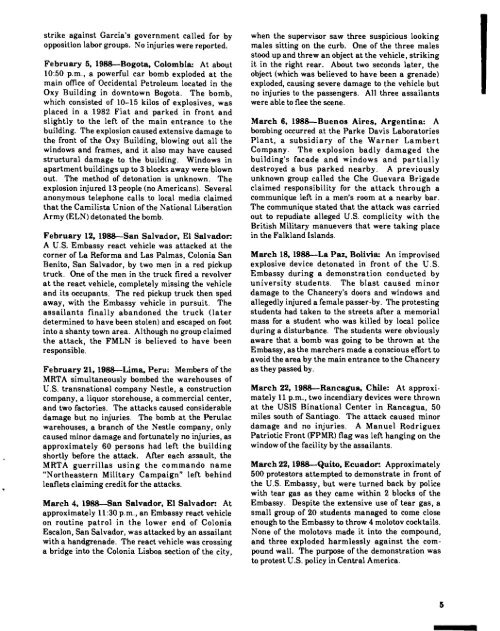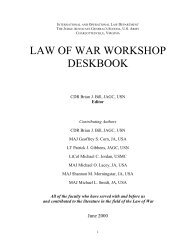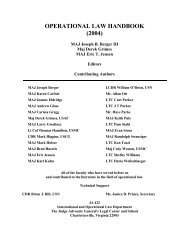Significant Incidents of Political Violence Against Americans 1988
Significant Incidents of Political Violence Against Americans 1988
Significant Incidents of Political Violence Against Americans 1988
Create successful ePaper yourself
Turn your PDF publications into a flip-book with our unique Google optimized e-Paper software.
strike against Garcia's government called for by<br />
opposition labor groups. No injuries were reported.<br />
February 5, <strong>1988</strong>--Bogota, Colombia: At about<br />
10:50 p.m., a powerful car bomb exploded at the<br />
main <strong>of</strong>fice <strong>of</strong> Occidental Petroleum located in the<br />
Oxy Building in downtown Bogota. The bomb,<br />
which consisted <strong>of</strong> 10-15 kilos <strong>of</strong> explosives, was<br />
placed in a 1982 Fiat and parked in front and<br />
slightly to the left <strong>of</strong> the main entrance to the<br />
building. The explosion caused extensive damage to<br />
the front <strong>of</strong> the Oxy Building, blowing out all the<br />
windows and frames, and it also may have caused<br />
structural damage to the building. Windows in<br />
apartment buildings up to 3 blocks away were blown<br />
out. The method <strong>of</strong> detonation is unknown. The<br />
explosion injured 13 people (no <strong>Americans</strong>). Several<br />
anonymous telephone calls to local media claimed<br />
that the Camilista Union <strong>of</strong> the National Liberation<br />
Army (ELN) detonated the bomb.<br />
February 12, <strong>1988</strong>--San Salvador, El Salvador:.<br />
A U.S. Embassy react vehicle was attacked at the<br />
corner <strong>of</strong> La Reforma and Las Palmas, Colonia San<br />
Benito, San Salvador, by two men in a red pickup<br />
truck. One <strong>of</strong> the men in the truck fired a revolver<br />
at the react vehicle, completely missing the vehicle<br />
and its occupants. The red pickup truck then sped<br />
away, with the Embassy vehicle in pursuit. The<br />
assailants finally abandoned the truck (later<br />
determined to have been stolen) and escaped on foot<br />
into a shanty town area. Although no group claimed<br />
the attack, the FMLN is believed to have been<br />
responsible.<br />
February 21, 198g--Lima, Peru: Members <strong>of</strong> the<br />
MRTA simultaneously bombed the warehouses <strong>of</strong><br />
U.S. transnational company Nestle, a construction<br />
company, a liquor storehouse, a commercial center,<br />
and two factories. The attacks caused considerable<br />
damage but no injuries. The bomb at the Perulac<br />
warehouses, a branch <strong>of</strong> the Nestle company, only<br />
caused minor damage and fortunately no injuries, as<br />
approximately 60 persons had left the building<br />
shortly before the attack. After each assault, the<br />
MRTA guerrillas using the commando name<br />
"Northeastern Military Campaign" left behind<br />
leaflets claiming credit for the attacks.<br />
March 4, <strong>1988</strong>--San Salvador, El Salvador:. At<br />
approximately 11:30 p.m., an Embassy react vehicle<br />
on routine patrol in the lower end <strong>of</strong> Colonia<br />
Escalon, San Salvador, was attacked by an assailant<br />
with a handgrenade. The react vehicle was crossing<br />
a bridge into the Colonia Lisboa section <strong>of</strong> the city,<br />
when the supervisor saw three suspicious looking<br />
males sitting on the curb. One <strong>of</strong> the three males<br />
stood up and threw an object at the vehicle, striking<br />
it in the right rear. About two seconds later, the<br />
object (which was believed to have been a grenade)<br />
exploded, causing severe damage to the vehicle but<br />
no injuries to the passengers. All three assailants<br />
were able to flee the scene.<br />
March 6, <strong>1988</strong>--Buenos Aires, Argentina: A<br />
bombing occurred at the Parke Davis Laboratories<br />
Plant, a subsidiary <strong>of</strong> the Warner Lambert<br />
Company. The explosion badly damaged the<br />
building's facade and windows and partially<br />
destroyed a bus parked nearby. A previously<br />
unknown group called the Che Guevara Brigade<br />
claimed responsibility for the attack through a<br />
communique left in a men's room at a nearby bar.<br />
The communique stated that the attack was carried<br />
out to repudiate alleged U.S. complicity with the<br />
British Military manuevers that were taking place<br />
in the Falkland Islands.<br />
March 18, <strong>1988</strong>---La Paz, Bolivia: An improvised<br />
explosive device detonated in front <strong>of</strong> the U.S.<br />
Embassy during a demonstration conducted by<br />
university students. The blast caused minor<br />
damage to the Chancery's doors and windows and<br />
allegedly injured a female passer-by. The protesting<br />
students had taken to the streets after a memorial<br />
mass for a student who was killed by local police<br />
during a disturbance. The students were obviously<br />
aware that a bomb was going to be thrown at the<br />
Embassy, as the marchers made a conscious effort to<br />
avoid the area by the main entrance to the Chancery<br />
as they passed by.<br />
March 22, <strong>1988</strong>--Rancagua, Chile: At approximately<br />
11 p.m., two incendiary devices were thrown<br />
at the USIS Binational Center in Rancagua, 50<br />
miles south <strong>of</strong> Santiago. The attack caused minor<br />
damage and no injuries. A Manuel Rodriguez<br />
Patriotic Front (FPMR) flag was left hanging on the<br />
window <strong>of</strong> the facility by the assailants.<br />
March 22, <strong>1988</strong>--Quito, Ecuador:. Approximately<br />
500 protestors attempted to demonstrate in front <strong>of</strong><br />
the U.S. Embassy, but were turned back by police<br />
with tear gas as they came within 2 blocks <strong>of</strong> the<br />
Embassy. Despite the extensive use <strong>of</strong> tear gas, a<br />
small group <strong>of</strong> 20 students managed to come close<br />
enough to the Embassy to throw 4 molotov cocktails.<br />
None <strong>of</strong> the molotovs made it into the compound,<br />
and three exploded harmlessly against the compound<br />
wall. The purpose <strong>of</strong> the demonstration was<br />
to protest U.S. policy in Central America.
















